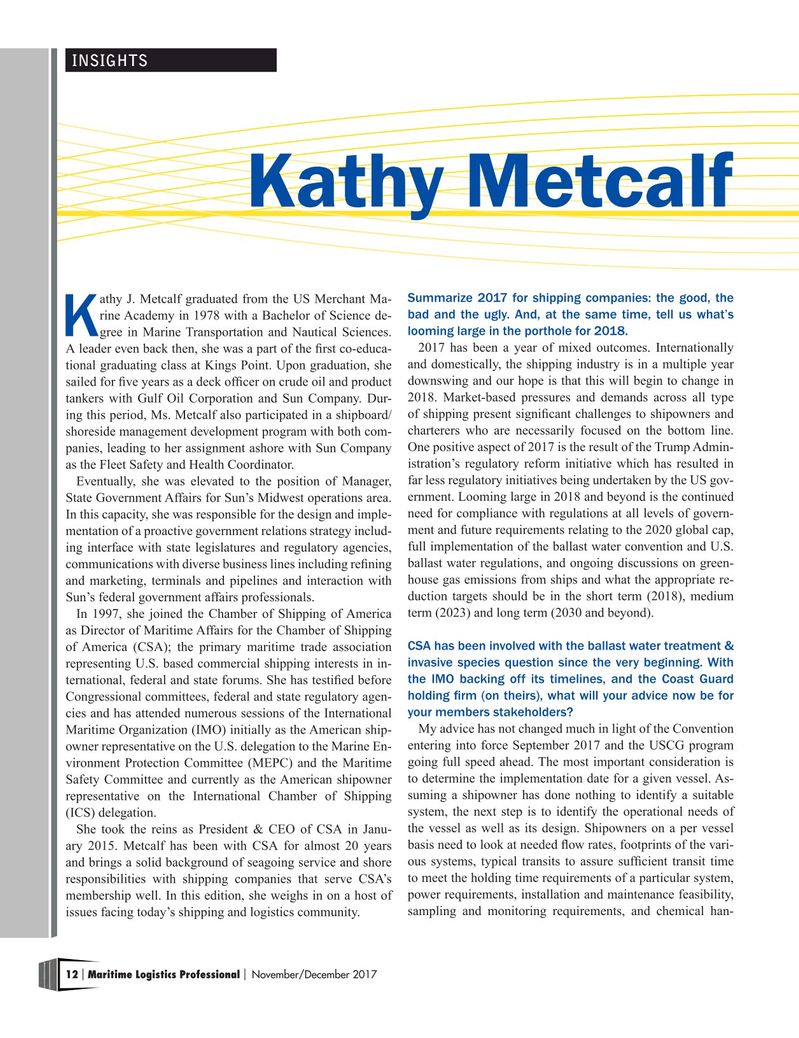
Page 12: of Maritime Logistics Professional Magazine (Nov/Dec 2017)
GREEN PORTS
Read this page in Pdf, Flash or Html5 edition of Nov/Dec 2017 Maritime Logistics Professional Magazine
INSIGHTS
Kathy Metcalf athy J. Metcalf graduated from the US Merchant Ma- Summarize 2017 for shipping companies: the good, the rine Academy in 1978 with a Bachelor of Science de- bad and the ugly. And, at the same time, tell us what’s
Kgree in Marine Transportation and Nautical Sciences. looming large in the porthole for 2018.
A leader even back then, she was a part of the frst co-educa- 2017 has been a year of mixed outcomes. Internationally tional graduating class at Kings Point. Upon graduation, she and domestically, the shipping industry is in a multiple year sailed for fve years as a deck offcer on crude oil and product downswing and our hope is that this will begin to change in tankers with Gulf Oil Corporation and Sun Company. Dur- 2018. Market-based pressures and demands across all type ing this period, Ms. Metcalf also participated in a shipboard/ of shipping present signifcant challenges to shipowners and shoreside management development program with both com- charterers who are necessarily focused on the bottom line. panies, leading to her assignment ashore with Sun Company One positive aspect of 2017 is the result of the Trump Admin- as the Fleet Safety and Health Coordinator. istration’s regulatory reform initiative which has resulted in
Eventually, she was elevated to the position of Manager, far less regulatory initiatives being undertaken by the US gov-
State Government Affairs for Sun’s Midwest operations area. ernment. Looming large in 2018 and beyond is the continued
In this capacity, she was responsible for the design and imple- need for compliance with regulations at all levels of govern- mentation of a proactive government relations strategy includ- ment and future requirements relating to the 2020 global cap, ing interface with state legislatures and regulatory agencies, full implementation of the ballast water convention and U.S. communications with diverse business lines including refning ballast water regulations, and ongoing discussions on green- and marketing, terminals and pipelines and interaction with house gas emissions from ships and what the appropriate re-
Sun’s federal government affairs professionals. duction targets should be in the short term (2018), medium
In 1997, she joined the Chamber of Shipping of America term (2023) and long term (2030 and beyond).
as Director of Maritime Affairs for the Chamber of Shipping of America (CSA); the primary maritime trade association CSA has been involved with the ballast water treatment & representing U.S. based commercial shipping interests in in- invasive species question since the very beginning. With ternational, federal and state forums. She has testifed before the IMO backing off its timelines, and the Coast Guard
Congressional committees, federal and state regulatory agen- holding frm (on theirs), what will your advice now be for cies and has attended numerous sessions of the International your members stakeholders?
Maritime Organization (IMO) initially as the American ship- My advice has not changed much in light of the Convention owner representative on the U.S. delegation to the Marine En- entering into force September 2017 and the USCG program vironment Protection Committee (MEPC) and the Maritime going full speed ahead. The most important consideration is
Safety Committee and currently as the American shipowner to determine the implementation date for a given vessel. As- representative on the International Chamber of Shipping suming a shipowner has done nothing to identify a suitable (ICS) delegation. system, the next step is to identify the operational needs of
She took the reins as President & CEO of CSA in Janu- the vessel as well as its design. Shipowners on a per vessel ary 2015. Metcalf has been with CSA for almost 20 years basis need to look at needed fow rates, footprints of the vari- and brings a solid background of seagoing service and shore ous systems, typical transits to assure suffcient transit time responsibilities with shipping companies that serve CSA’s to meet the holding time requirements of a particular system, membership well. In this edition, she weighs in on a host of power requirements, installation and maintenance feasibility, issues facing today’s shipping and logistics community. sampling and monitoring requirements, and chemical han- 12 Maritime Logistics Professional November/December 2017 | |

 11
11

 13
13
